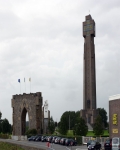IJzertoren
Archaeology »
Archaeological Monuments » IJzertoren
IJzertoren - Belgium
IJzertoren is located in Diksmuide.
IJzertoren monument was established on 1946.
Primary threats to IJzertoren :
The Ijzertoren is a memorial along the Belgian Yser River in Diksmuide. There have been two IJzertorens, the first built after the First World War by an organization of former Flemish soldiers.
Historical facts of IJzertoren :
- The IJzertoren, also known as the Yser Tower, is a prominent monument located in Diksmuide, Belgium. It serves as a memorial to commemorate the Flemish soldiers who lost their lives during World War I, particularly those who fought in the Battle of the Yser. The monument stands tall as a symbol of Flemish nationalism and resilience.
- The IJzertoren was established in 1946, making it an important historical landmark with deep significance for the Flemish people. The tower is constructed mainly from reinforced concrete and reaches a height of approximately 84 meters, making it one of the tallest structures in the region. Its distinctive design, characterized by a slender tower with a cross at the top, has become an iconic representation of Flemish identity.
- Beyond its architectural significance, the IJzertoren holds great historical importance. It stands on the site where the Flemish front line was established during World War I, serving as a strategic defense position against the German forces. The battle that took place at the Yser River was a pivotal moment in Belgian history, and the IJzertoren pays tribute to the soldiers who fought valiantly to defend their homeland.
- The monument also serves as a memorial for the Flemish soldiers who lost their lives in the war. Inside the tower, there is a crypt that houses the remains of fallen soldiers. This solemn space allows visitors to pay their respects and reflect on the sacrifices made during the conflict. The crypt serves as a poignant reminder of the human cost of war and the importance of preserving the memory of those who fought.
- In addition to its commemorative purpose, the IJzertoren has served as a rallying point for the Flemish nationalist movement. Throughout history, the Flemish people have sought greater recognition and autonomy within the Belgian state. The tower has become a symbol of their aspirations for cultural and political independence.
- Over the years, the IJzertoren has witnessed various controversies and conflicts. In 1946, shortly after its construction, it was blown up by a bomb in a politically motivated act of vandalism. However, the monument was rebuilt and restored to its former glory, ensuring its continued presence as a symbol of Flemish heritage and resilience.
- Despite occasional tensions, the IJzertoren remains an important cultural and historical landmark, attracting visitors from all over the world. It serves as a reminder of the past and a call to honor the sacrifices made by those who fought for their ideals. The tower stands as a testament to the indomitable spirit of the Flemish people and their enduring commitment to their heritage.
- In conclusion, the IJzertoren monument in Diksmuide, Belgium, holds significant historical importance as a commemoration of the Flemish soldiers who lost their lives during World War I. Established in 1946, the tower serves as a symbol of Flemish nationalism and resilience. With its towering presence and a crypt containing the remains of fallen soldiers, the IJzertoren stands as a solemn reminder of the sacrifices made in defense of the homeland. Despite controversies and conflicts, the monument has persevered, becoming an iconic representation of Flemish heritage and aspirations for greater recognition and autonomy.

